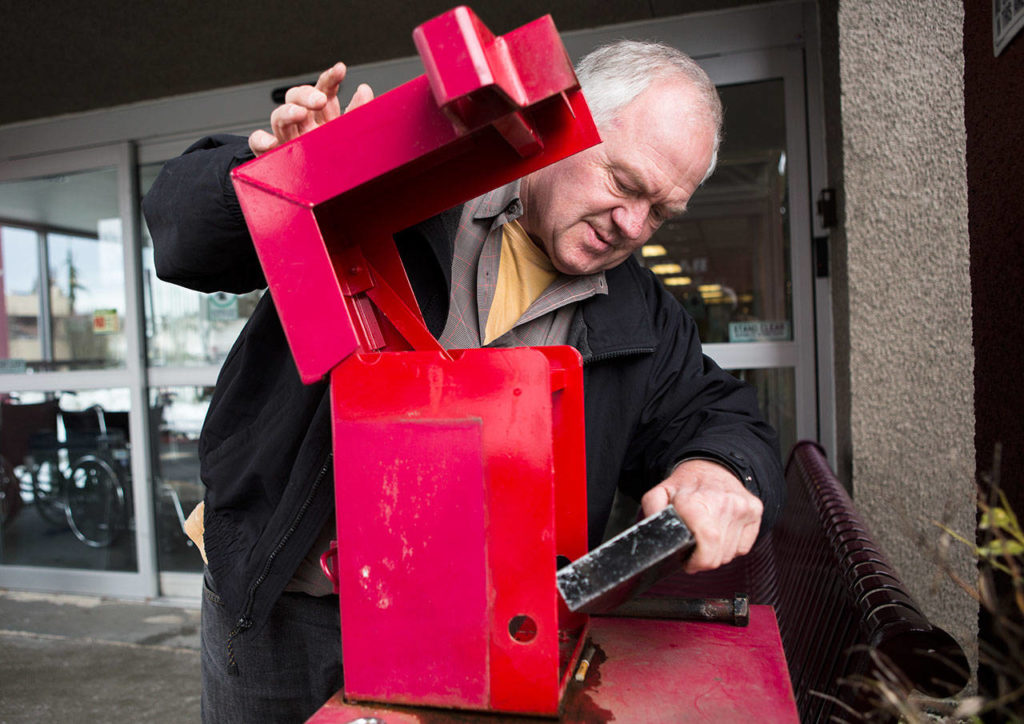Got any quarters jingling around in your pocket?
Um. Probably not.
That’s why those newspaper vending machines are vanishing from the sidewalks.
What’s up with that?
Jere Grubb is The Daily Herald’s rack mechanic. He maintains the more than 200 bright red Herald coin-operated machines still standing along the streets of Snohomish and Island counties.
For now.
The boxes are going the way of telephone booths. USA Today and other papers have phased out their coin machines. Most publications have cut back.
Instead, there are coinless newsstands inside stores, where shoppers grab a paper and pay for it at the checkout.
Most people don’t want to mess with those clunky vending boxes — even though it’s cheaper. Herald daily editions cost $1 at the store racks, but at most boxes are only 75 cents. On Sunday, you have to scrounge up $1.50 in coins, compared with $2 at the store for the same thing.
It pays off. Clinking coins nets an annual savings of $78 on daily copies and $26 on Sunday issues of The Herald, or more than $100 for both. That’s like pennies from heaven.
But nobody wants pennies anymore, either.
Grubb, 63, a widower with a blended family of seven kids and 21 grandkids, has spent some 50 years in the newspaper biz. He is tied as the longest-serving worker — 46 years and change — at The Herald. Before that he was a paperboy and also hawked papers on a Casino Road corner before the Boeing freeway came through. As a youth carrier of the year, he had lunch in Olympia with then-Gov. Daniel Evans. His top door-to-door sales earned him several trips to Disneyland.
After joining the staff in 1972, he taught kids how to sell newspapers and escorted winners to Disneyland. Telemarketing ended that.
These days, his position as operations manager sends him on adventures around the region, overseeing the old-fangled boxes. Some are mechanical and others use batteries. Tinkering and TLC don’t always do the trick, so he keeps a stack of spare parts by his desk and in his car.
His delivery drivers put the papers in the boxes, using slug tokens. Grubb collects the coinage.
The machines also take nickels and dimes. No pennies, as it says on the front.
“What people do is they put pennies in, and then it jams up. Guess who has to go fix it?” Grubb said.
Paperclips are also a pain.
He also finds European francs, Philippine centavos, Canadian loonies and toonies.
Occasionally, a dollar bill jams the slot. “I don’t know what they’re thinking,” Grubb said.
He hands over the stash of cash to Herald employee Debbie Wise. She fishes out foreign coins and slugs from the sea of silver on her desk.
Some bags have 25 pounds of quarters. According to the internet, a pound of quarters adds up to $20. An armored car picks up the loot.
The most profitable site is Tom Thumb grocery in Lake Stevens, where four Herald boxes deliver the news.
“It has been the best-selling location for years and years,” Grubb said. “The style of the machine is the K4916, for those people who are in the know.”
Many spots have two boxes, so if one breaks or is empty another is at the ready.
Grubb sometimes removes the mechanism and puts the dispenser on the honor system, which means it opens regardless of coin input, so people can get their newspaper fix.
“If the customer keeps going there and it’s not working it discourages him for the next time,” Grubb said. “What I want to do is guarantee that it’s going to work. Keep them coming back. Build that habit, because that’s what newspaper reading is.”
Or was.
The industry is shifting.
(First, a disclaimer: The Daily Herald is pretty much a cubicle bullpen of utilitarian desks and bodies stoically glued to computer screens. That’s why desks clinking with coins and mechanical parts brought out the busybody in me, so this is not meant to be promotional.)
Digital display stands are coming to a store near you soon.
The newspaper racks will be topped with flat screen monitors that read you.
“It has an optical lens on top of the unit,” said David Egge, digital sales development director of Sound Publishing, which owns The Herald. “Within 15 feet it will know if you’re male or female and it will know age. It will lump you into an age bracket.”
That way, advertisers and retailers can target demographics. The digital screen racks have been used for two years by a Sound partner news outlet in Hawaii.
The content of Sound Video Network will be local, Egge said, with sports scores, weather, news and a broadcast anchor.
But you’ll have to pick up a newspaper to read What’s Up With That.
Andrea Brown: abrown@heraldnet.com; 425-339-3443. Twitter @reporterbrown.
Talk to us
> Give us your news tips.
> Send us a letter to the editor.
> More Herald contact information.




























